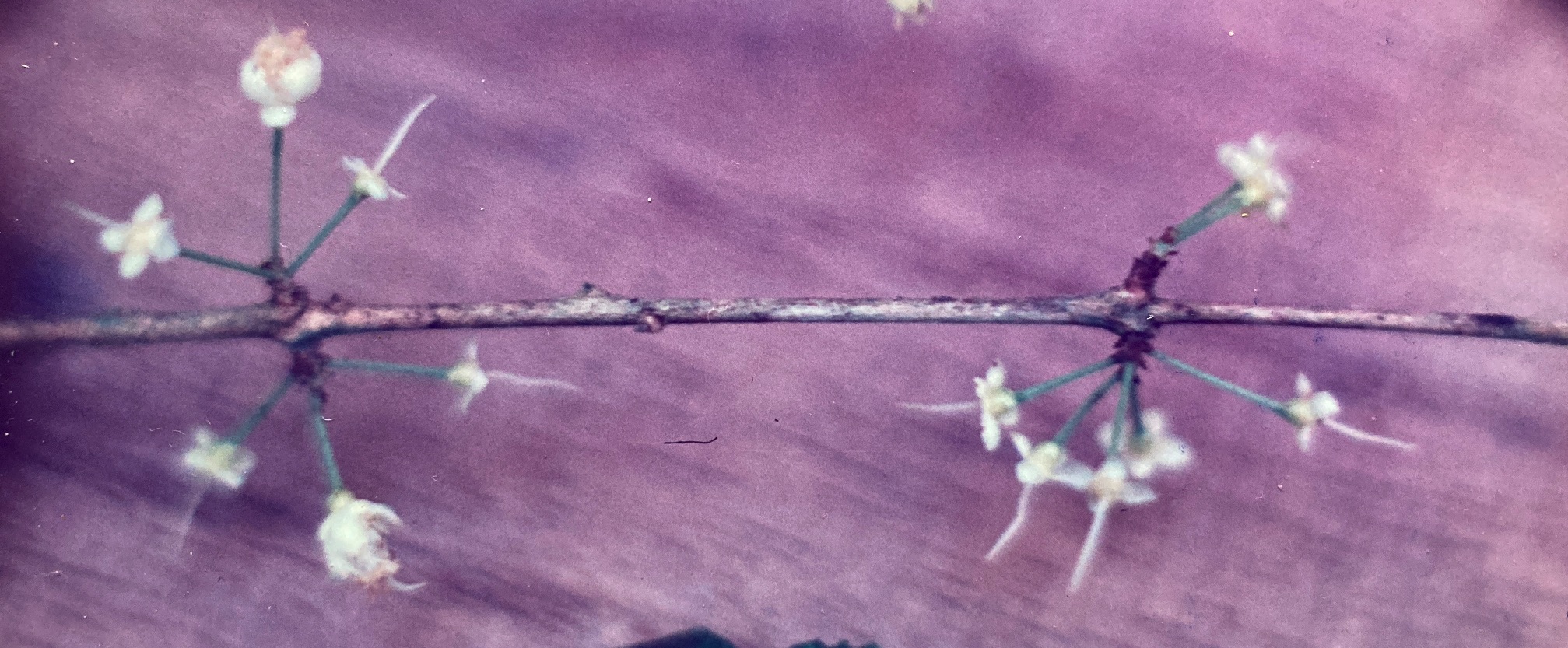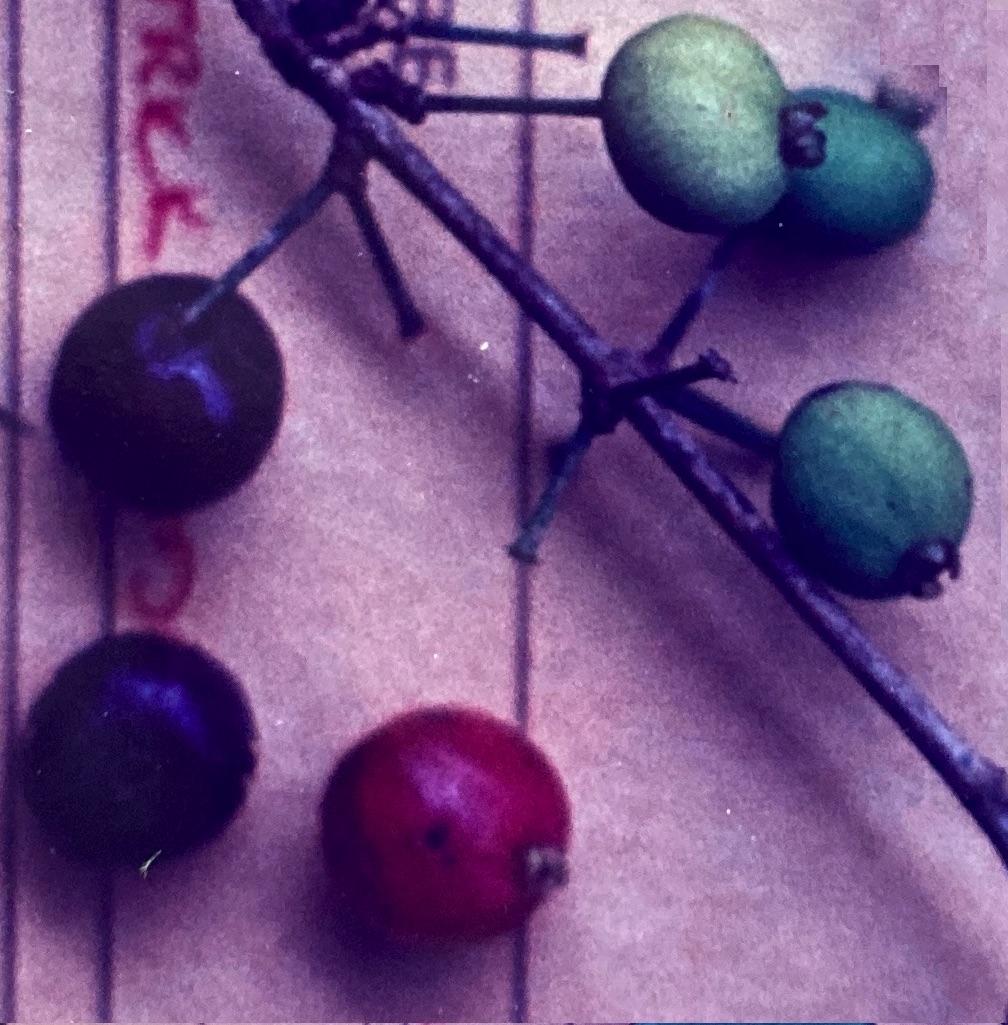Eugenia argyrea Lundell.
Myrtaceae
Occasional understory evergreen tree (8-12 m) found growing in primary forest shade as well as along the better illuminated margins of streams. This small tree is noteworthy as a prototypical member of its genus and family, since it possesses most of the anatomical features usually associated with these botanical categories. Eugenia‘s small stature, infrequent and subtle fertility cycles, and thin, fine-textured canopy make it an inconspicuous component of the southern Pacific flora.
Description: Eugenia has a small (10 cm), mostly straight and cylindrical trunk covered by dark colored, smooth bark. Branches, found along the upper half of the trunk, are thin and long. Emerging at right angles to the main bole, they continue to extend horizontally outward. The finely-textured crown formed by these limbs is of medium density and irregular form. Leaves (9 by 2.5 cm) are dark green, simple, and oppositely arranged. The smooth, clean blades are narrowly elliptical in shape and they taper slowly to points at both ends – with well developed drip tips (1 cm) and short, thin petioles (0.4 cm) occupying the extremes. Strongly pronounced secondary leaf veins are absent, though the blade-dividing mid-rib is clearly in evidence. New foliage may be produced at almost any time during the year, with about 20% of the canopy being renewed at such times. During these well synchronized events, the soft and supple new leaves sport an eye-catching, coppery color.
Eugenia flowers (3 mm) are minute, delicate, and white. Supported by a green pedestal (1 cm), each blossom is composed of 4 sepals, 4 tiny petals, multiple stamens, and a central pistil. Flowers are borne in compact cymes that can be found growing from current leaf axils as well as from axil scars located along the inner, bare portions of the branches. The distribution of blossoms within the crown is often unequal and irregular, with certain (often lower) portions of the crown being more fertile than others. Branches in full bloom are noteworthy, for they are highlighted by a subtle and understated dusting of white. Flowering periods are short, irregularly timed, but well synchronized events of less than annual frequency. During fertile years, flowers appear for one or two, two-week periods that occur sometime between the months of July and October (inclusive). Immediately thereafter, the delicate petals are shed and rain to the ground – leaving behind the swelling ovaries on their pedestals.
Fruits grow rapidly into small, green, spherical berries (6 mm in diameter) whose most noteworthy feature is the star-shaped flower calyx that persists distally on each. Ripening requires more time (up to several months), with fruits finally changing color from green through red and finally to black. A thin layer of juicy flesh surrounds a single, spherical, flesh-colored seed (4 mm). Arranged in small groups along the twigs and thinner branches, the fruits continue to be supported at the tips of the now stiff and woody pedestals. Harvests are variable in intensity and timing (correlated, as they are, to the irregular flowering events), but occur between November and February of fertile years. Fruitfall itself lasts for about six weeks.
Similar Species: Murta (Eugenia acapulcensis) and Guayabon (Myrcianthes fragrans) are Myrtaceaes whose leaves and fruits are similar to Eugenia‘s. All have small, oppositely arranged leaves and their calyxed, rounded fruits turn from green through red to deep purple or black when ripe. Murta fruits even smell like those of Eugenia and they share the same type of pit or stone inside. However, the flowers and fruits of Eugenia argyrea are much smaller and less ornate than either those of Murta or Guayabón. The location of Eugenia argyrea in deep primary forest (and not among the stands of sand and salt tolerant, coastal vegetation) is another distinguishing factor. Finally, Eugenia‘s leaves are more eccentrically elliptical than are the more rounded blades of either Murta or Guayabón. Xylopia frutescens and Hirtella racemosa, two additional species of low stature and fine crown texture, have alternately arranged leaves.
Natural History: Eugenia flowers are pollinated by insects. Delicate, these blossoms shed their petals with ease – a characteristic shared by most Myrtaceae inflorescences. Fruits are probably distributed by birds, bats and arboreal mammals (Croat, 1978).
Distribution: In Manuel Antonio National Park (MANP), Eugenia argyrea is usually restricted to the lower layers of primary forest, though it is also sometimes found along streamsides. It ranges from Mexico to Colombia.
Images: Trunk Leaf Flower Bud Flower Fruit


